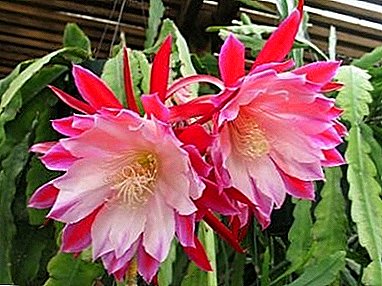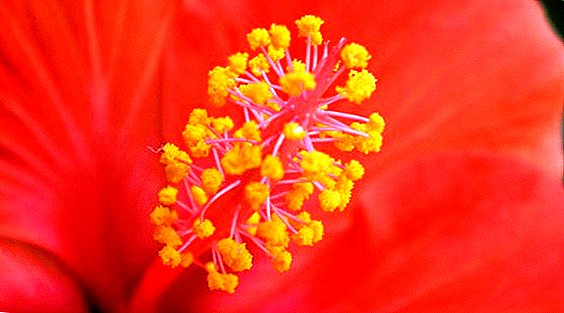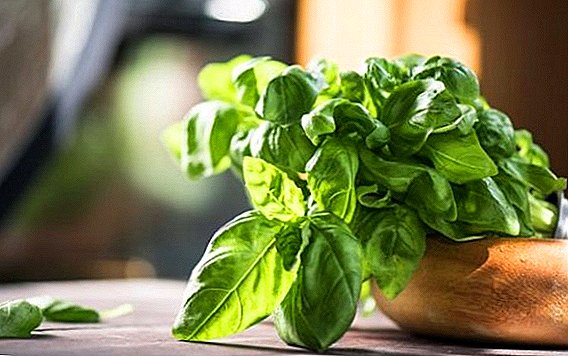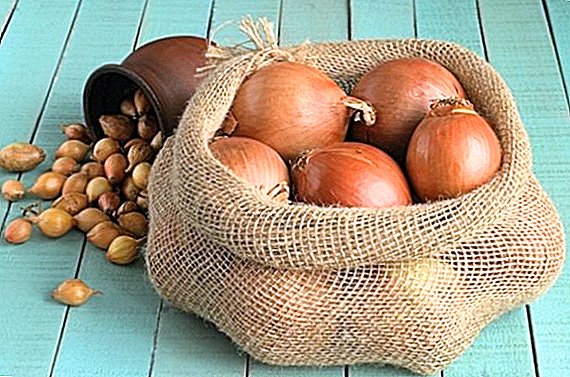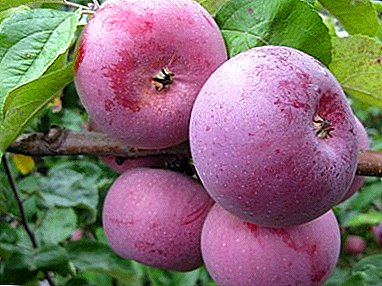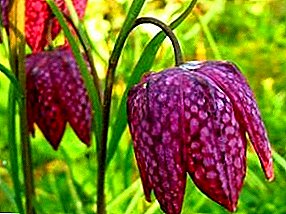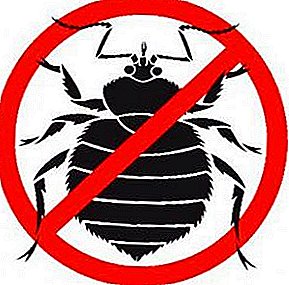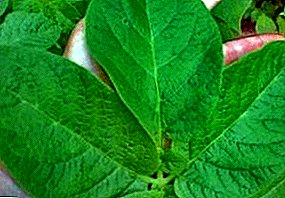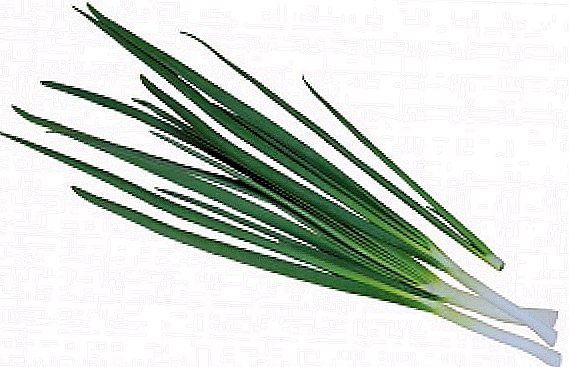
Onions are an integral part of most dishes, in which it can be used not only as an additional ingredient, but also as a main ingredient.
After all, this vegetable has not only good taste, which receives after a special heat treatment, but is extremely useful.
But even more useful and loved by all is not a simple onion, but green, grown only on a feather.
After all, what can replace fresh greens in early spring, as onions not rich in vitamins, able to give vitality to an organism worn out after a long winter.
It is no less popular for the external decoration of dishes, because it gives them showiness and freshness.
Planting green onions: on varieties and features of the preparation of materials
Growing green onions on a windowsill cannot be considered a relic of Soviet times, since such a product is not only a budget savings, but also a guarantee of environmental friendliness. It is in connection with the last factor that many people want to get all the vegetables from their own beds. Of course, in this case it is not always possible to have greens all year round, but you will not need to buy it constantly.
Choosing the best varieties of onions that can be grown on a feather
You can grow green onions from absolutely all varieties. However, to obtain a large abundance of greenery, it is better to choose the onion, which has a large number of buds. To do this, choosing an onion, if such opportunities fall out, you can cut it across and determine the number of buds on your own.
However, you can simply select them below, the best variety in your opinion and look for him.

Onion batun. Sometimes it can be found under such names as fistulous, winter, sandy or Tatar.
Highly fruitful onions with smooth beautiful greens.
When using perennial varieties of this onion, greens can be cut even 2-3 times during the whole growing season (for annuals only 1 time).
The yield of the feather of this onion is about 20-35 kilograms from an area of 9 m2.
Leek. This name is better known by the people, although sometimes such a name as a pearl-bow is also used. The lower part is most often used, and many upper leaves are simply thrown away, but they have a very delicate taste. Outwardly, they have much in common with garlic leaves, but much wider than they are.
From a bed of 9 m2, you can collect about 20 kilograms, even if you provide the plant with the most minimal care.
Onion Slizun. The leaves of this onion also have some similarities with garlic. In particular, they have a spicy garlic aroma, and the leaf structure is flat and rather wide.
They are also distinguished by a gentle structure. The virtues of this onion are ripening and high yield.
Also, thanks to good frost resistance, it can produce crops year-round in protected areas all year round, and when grown in open beds it remains green until frost.
Chives. It is also found under the more famous name - incisor. The main advantage of this variety of onions are its leaves - thin and long, up to 50 centimeters. Also, they have a very good flavor and are capable of being stored for an extended period of time.
When storing does not change the structure or taste. It can be up to 30 kilograms to gather from a bed of 9 m2.
Multi-tiered onions. Other names of this variety are Egyptian, Canadian. Among gardeners it is considered the most not whimsical and resistant to low temperatures.
Even a bat onion cannot compete with it on such criteria as the yield and quality of greens produced. You can leave in the soil for the winter, while it is not damaged and easily enters the growth in the new season.

Shallot. Quite a famous onion, widely used for cooking various dishes, and not just their decorations.
The leaves have not only good taste, but are stored for a very long time, without losing their juiciness.
In growing this onion is not whimsical.
The yield of shallot can be different, ranging from 25 to 45 kilograms from 9 m2.
Also, it is worth mentioning such famous varieties as Armazansky, Bezssonovsky, Rostovsky, Amber and of course the Black Prince bow.
Discussing the conditions for growing onions on the feather
As you have seen from the description of varieties of onions for growing on the feather, almost all of them have good resistance, and not only against frost.
This bow is not quite whimsical. In order to grow a good onion head, you will have to apply a lot of fertilizer to the soil and provide the necessary care, trying not to allow it to be turned into greens. This is exactly what we need here.
But nevertheless, try to provide a bed with onions with a sufficient amount of solar or artificial light (after all, often such onions are grown both indoors and in greenhouses). This is necessary for him, both for acquiring a bright green color, but also for taste.
With very low light onion leaves of course can be very stretched and become very long, but in this case they will be very thin and not attractive both for dishes and for further sale on the market.
Also, when choosing a bed and a place in the garden, for planting such an onion, do not forget to take care that the soil type has a good ability to retain moisture in itself. However, do not miss from the attention that with a strong abundance of moisture onions can also suffer and grow poorly (especially in the cold season). For this reason, do not plant this plant in places where the groundwater level can rise too high.
The type of soil for planting onions in an open garden bed may not play a big role, but in greenhouses, when growing greens in boxes, it is better to use compost, humus or peat, which after planting the bulbs is filled with soil.
How to prepare a bow for planting: basic rules and comments

First of all, it is necessary to clarify the fact that planting onions on the feather can be carried out not only with the help of onion sets, but also with seeds. In general, both methods give a good effect, the difference will only consist in the fact that onions are planted and sown at different times. Yes, and wait for the new crop in the second case will have much longer.
When using bulbs as a planting material, they must be soaked in water before planting directly. This will help the bulbs to be saturated with moisture so that during the period of adaptation to growth in the new soil it will not dry out and be able to give good results.
It is best to take those bulbs, the diameter of which is not less than 2.5 centimeters, but not more than 4. Also, it is usually recommended to cut off the top of it. Thanks to such simple actions it is possible to significantly affect the power of forcing green. Also, it contributes to an increase in the amount of greenery: in comparison with a simple planting without preparation of the material by 55-75%.
Growing onions on a feather from seeds, although more stretched in time, however, is a more budgetary way, at times increasing your income if you are engaged in this business for sale.
Also, you can save and buying perennial varieties of onions. Purchased seeds do not need to be prepared for planting: they are usually sold pretreated, not only for the best seedlings, but also for obtaining a more sustainable plant. Its seeds, like bulbs, can be pre-soaked in warm water, which will stimulate them to grow.
We are engaged in the preparation of soil and beds for planting onions
The soil requires special preparation for sowing onion seeds, but the same procedures and actions can be carried out before planting onions on the feather with the help of bulbs. So, you need to dig up the soil very carefully - the deeper, the better. Deep digging is also needed in order to bring into the soil a sufficient amount of organic substances that well stimulate the growth of onions.
Mineral fertilizers usually do not need such onions, although in the presence of very fertile soil it is best to use them. Before sowing, the dug up soil is well leveled and slightly compacted, so that the soil does not subside with the seeds, and especially with the bulbs. The beds for planting onions usually do not make wide, because it is believed that on narrower ones you can achieve a higher yield.
It is also interesting to read about the cultivation of onion seedlings
Time and timing of planting onions, for growing it on the pen, in the beds, in greenhouses and in greenhouses

There is practically no difference in the time of planting onions of different species and varieties. If it is planted in open ground, it is usually done in late autumn just before the frost.
Such a late time is necessary so that the bulb does not have time to enter growth, which is extremely undesirable in connection with the approach of frost. But it is also impossible to plant it very late, already in the frozen soil it is impossible, such bulbs will definitely suffer. It is better to wait for the earliest spring, when the snow will come down, and then plant your bulbs.
Also, the cultivation of onions on the feather can be carried out in greenhouses and greenhouses. At the same time, onion greens can grow well in the greenhouse the entire cold period of time, delighting you with fresh vitamins. Usually it is grown in such a way from October until April, when the greens will begin to appear on open beds.
But since February you can plant bulbs and in greenhouses, the greens from which you can get until May.
If we are talking about sowing seeds of onions, for its cultivation on the feather, then it is best to carry out this procedure in mid-July. This will allow you to get a good onion, or rather its juicy leaves, by the earliest spring.
How to efficiently use the area of the beds for planting onions on the pen: discuss ways of planting
You can plant bulbs for growing them on a feather in two ways, which are as follows:
- Bridge way. For this method, a very large amount of planting material is used, because the bulbs are very densely laid out next to each other, with their roots slightly tucked in the soil. Such "bridges" after planting fall asleep with a layer of soil for at least 2-3 centimeters (but no more, since a thick layer of soil will retard the development of the plant).
- Tape method. It lies in the fact that the bulbs are planted in a specially and prematurely prepared for this furrow. The distance between the bulbs should be about 1-4 centimeters, but between rows should leave a space of 10-20 centimeters.
With such a planting per 1 m2 usually takes at least 11-13 kilograms of bulbs.
After planting, the beds are leveled, which allows the bulbs to fall asleep with soil.
Onion seeds are sown in a completely different way to obtain greenery from it. To do this, on grooved beds, furrows are made with a row spacing of at least 32-42 centimeters. Seeds are sown in these furrows, rather abundantly.
Of course, that after sowing the seedlings are very thick. Therefore, when real leaves of onion appear above the surface, garden bed is recommended thin out. Left one plant at a distance of 3.5-5 centimeters.
Chives and care for them: what allows you to get high yields?
There is no doubt that the bow needs constant supervision and care. After all, it will allow to get higher yields. Besides the fact that planting plants according to a certain pattern and taking into account its main needs, it is important to take into account other important aspects of agricultural technology, which involve loosening and watering the soil, feeding of developing plants.
How often and why to loosen the soil beds with green onions?

Loosening the soil - this is one of the best ways to deliver oxygen to the roots of plants.
For this reason, loosening should be done quite often, in no case allowing the formation of a dense crust on the soil surface.
For this reason, on the second or third day after watering you should definitely not forget about loosening.
Does the onion need watering and how much moisture will be useful for it?
The answer to the question will be unequivocal - of course, necessary. Moisture refers to the main nutritional components for onions. With its help to the plant and other nutrients that are in the soil. Therefore, the optimum frequency of watering is about 2 times a week.
Of course, what is usually strongly this issue will depend on the type of soil and its ability to retain moisture in itself. Also, weather conditions play an important role in the frequency of irrigation: during hot summers, watering is often carried out 3 times a week, in very rare cases and every day.
Also, the older the onions, the less watering they need.
We feed green onions: what fertilizers can I use?
Feeding onions are usually carried out in the form of irrigation using special solutions. The latter are prepared by adding to 1 liter of water, either 1 gram of urea, or nitroammofoski.
It is best to start feeding when you have already begun to cut the greens. In this case, the fertilizer will give strength to the bulb in order to re-grow the damaged feathers. If fertilizing is not used, then over time the onion leaves will become thinner and duller, their taste and aroma will be lost.
Removing weeds: how not to run the beds?

Remove weeds from the beds is also important.
After all, with a large number of them, the plant may lack nutrients, especially if it is only planted onions or grown from seeds.
Thus, it is best to keep the soil on the bed of black.
Also, when growing onions on a feather between the rows, they are usually not used for growing dill, as is done when growing onions.
Care for onions in the winter season: we shelter the beds with the help of mulch
We have already written above that onions are usually planted for winter. Despite its good stability, it is still better to hide beds with it.
If podzimny planting of bulbs was used, then the bed is completely covered with a dense layer of 3.5-5 centimeters, consisting of manure or humus. In early spring, this layer is removed to allow plants to grow. However, so that the cold does not affect their growth, it is better set over the bed film framewhich will serve as something like a greenhouse.
When sowing seeds by the onset of winter, onion feathers usually reach a length of 20-30 centimeters. To save them, the beds should be covered with straw or peat. With the advent of heat, when it will be possible to remove the mulch, under it you will find fresh greens that will continue to grow thanks to the arrival of heat.


